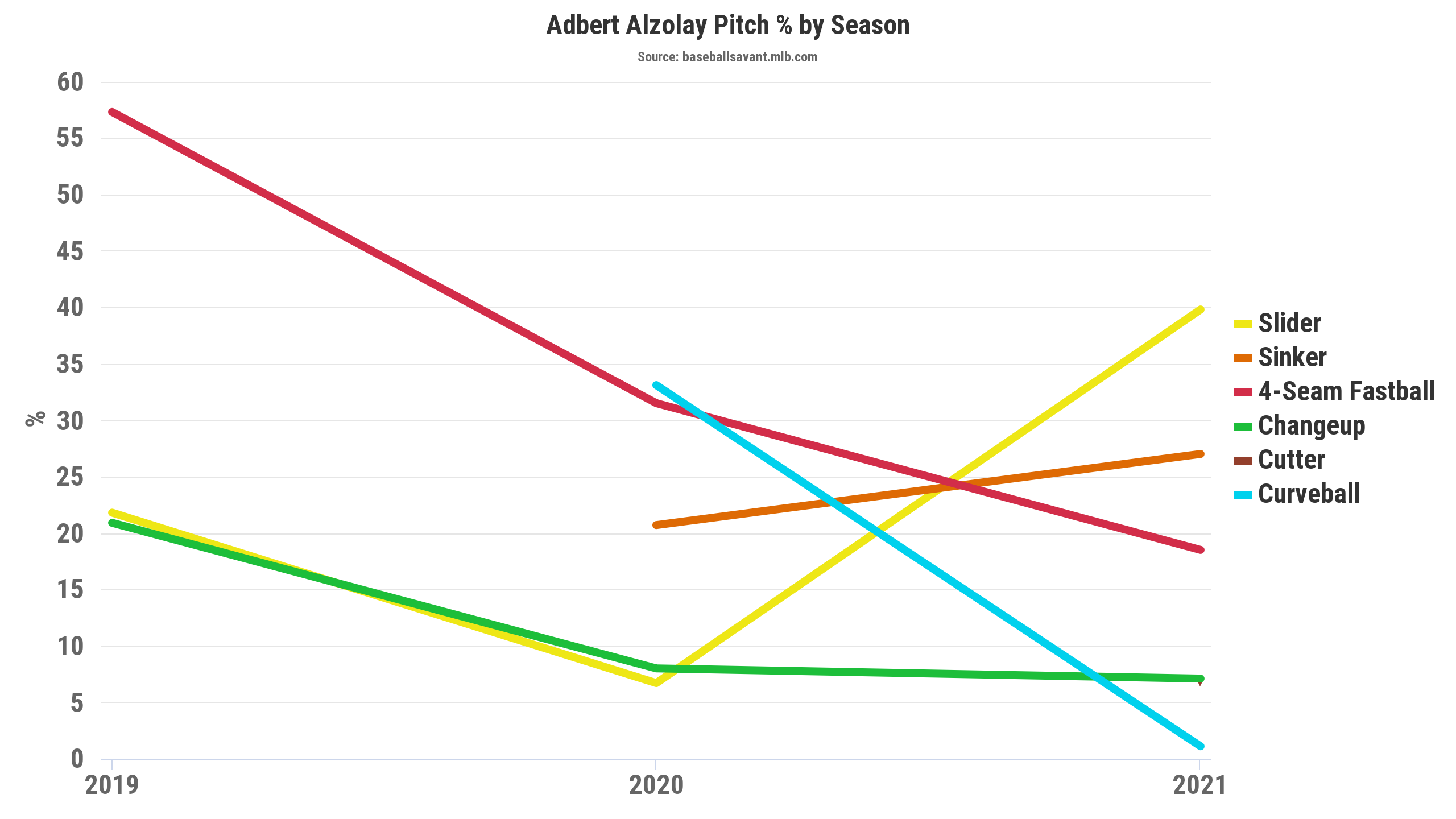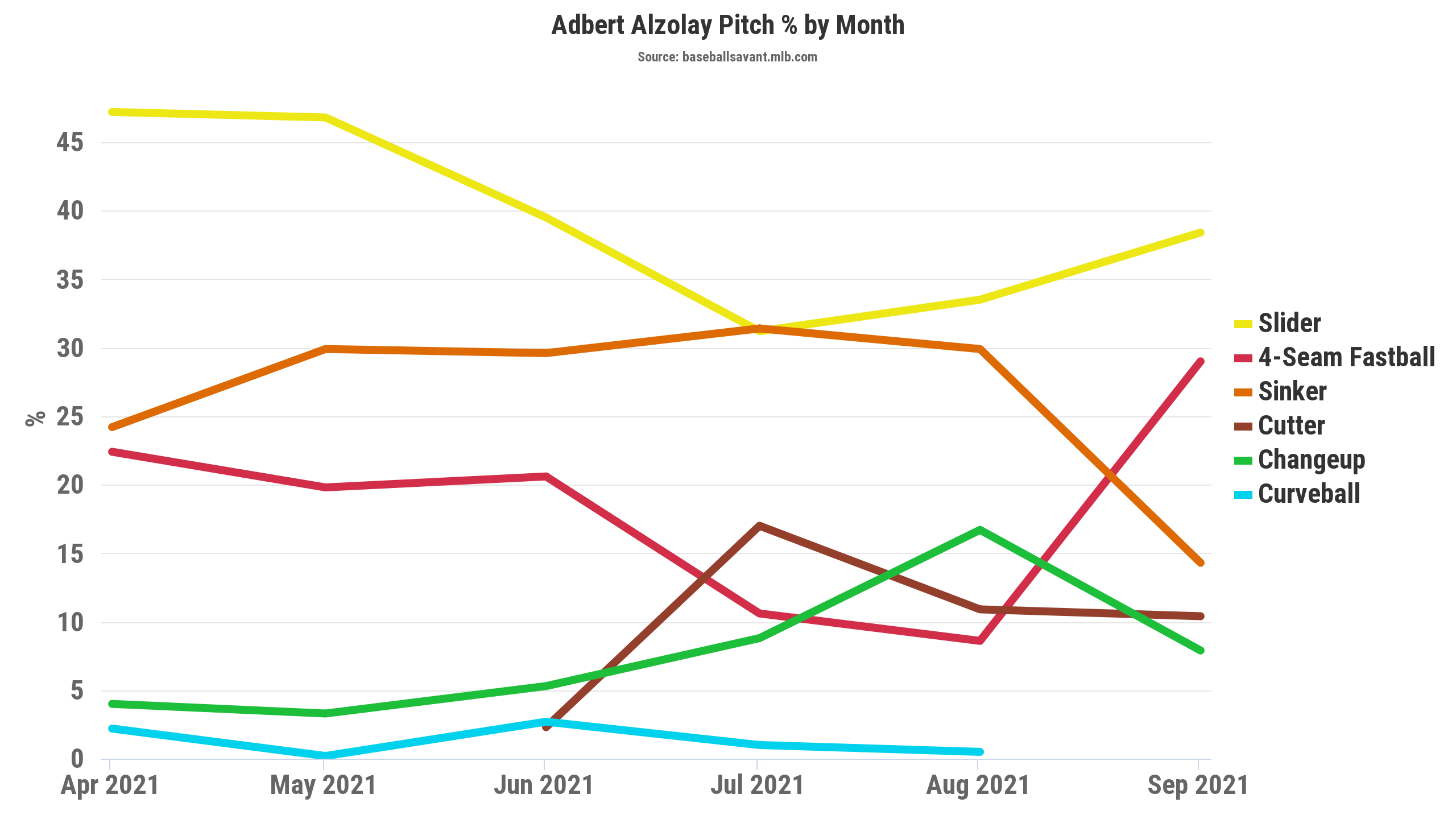The Cubs finished 71-91 last season, which was their first losing season since 2014. While Chicago is in a rebuilding process with Jed Hoyer, who took over from Theo Epstein as President of Baseball Operations in November of 2020, this organization is still looking to improve in 2022, with pitching being the primary emphasis this offseason.
Before the lockout, the Cubs added two starting pitchers, with the hope that these acquisitions will improve a rotation that ranked 27th in starting pitcher ERA in 2021. They acquired Wade Miley off of waivers, and he should add a veteran left-handed presence in the rotation in 2022. Furthermore, the Cubs were able to sign former Blue Jay and Met Marcus Stroman to a three-year deal.
Already, Stroman has seemed to embrace the city, and players and fans alike have embraced him in return:
Can’t wait to get to work! @PatrickWisdom5 @Cubs https://t.co/9i6TCOkoJZ
— Marcus Stroman (@STR0) December 17, 2021
While Miley and Stroman will undoubtedly help this Cubs rotation in 2022, they will need some improvement from pitchers already in their organization if they want to improve upon their 71 wins from a year ago.
A primary key for the Cubs (as well as fantasy managers looking for starting pitcher value in 2022) could be 26-year-old right-hander Adbert Alzolay, who posted a 5-13 record to go along with a 4.60 ERA in 125.1 IP. According to Fangraphs’ Roster Resource’s Cubs Depth Chart projection, Alzolay is expected to be a number four starter for the Cubs in 2022. He will likely need to prove himself this Spring in order to solidify his spot in the rotation on Opening Day.
Granted, Alzolay’s ERA wasn’t exactly impressive, and he had his fair share of struggles with the long ball in 2021 (his HR/FB rate in 2021 was 23.1 percent). However, when looking deeper into his metrics, Alzolay could be due for a breakout in the Cubs rotation in 2022, especially considering the intriguing adjustments he made last year, especially in regards to his pitch mix.
Hence, Alzolay could be a crucial part of the rotation for the Cubs and fantasy managers next season, especially if he can continue to refine his pitch arsenal this Spring.
Alzolay and K-BB Percentages
Signed by the Cubs in 2013 out of Venezuela, Alzolay was a Top-10 prospect in the Cubs system in 2018 (No. 2), 2019 (No. 6), and 2021 (No. 6), according to Baseball America (he was the Cubs’ No. 11 prospect in 2020). Before last season, Alzolay had two previous cups of coffee with the Cubs during the 2019 and 2020 seasons.
In his rookie debut, Alzolay made four appearances (including two starts) and posted a 7.30 ERA in 12.1 IP. In 2020, even though he only made six appearances and pitched 21.1 innings, he improved his ERA to 2.90 and struck out 29 batters while only allowing 12 hits and 13 walks.
Thus, it’s not a surprise that many Cubs fans, and even fantasy managers, were hoping for a breakout from Alzolay last year, even though many going into the season were not sure where the Cubs would place him initially (PL’s own Nick Pollack ranked him 128th in his Top 200 going into 2021, but he even mentioned that he would be fighting for a rotation spot at the time).
What Alzolay does incredibly well, as his BA scouting report mentioned, is “pounding the strike zone” and generating a high percentage of strikeouts while minimizing walks. This makes him an interesting late-round option for many fantasy managers.
In 2020, Alzolay posted a walk rate of 14.9 percent, which placed him in the bottom four percent of the league, and minimized the high number of strikeouts (33.3 percent K rate) he generated that season. Last year, even though his K rate fell to 24.7 percent, his walk rate regressed to 6.6 percent, an 8.3 percent improvement from 2020.
As a result, the Venezuelan-born pitcher not only led all Cubs starting pitchers with 30 or more innings pitched in K-BB percentage (16.9 percent as a starter), but also in other categories such as xFIP and SIERA, as evidenced in the table below:
| K% | BB% | K-BB% | xFIP | SIERA | |
|---|---|---|---|---|---|
| Adbert Alzolay | 24.1% | 7.2% | 16.9% | 3.89 | 4.02 |
| Trevor Williams | 23.8% | 8.6% | 15.2% | 4.02 | 4.20 |
| Alec Mills | 17.0% | 5.7% | 11.3% | 4.13 | 4.42 |
| Kyle Hendricks | 16.7% | 5.6% | 11.1% | 4.61 | 4.70 |
| Justin Steele | 19.8% | 10.4% | 9.4% | 4.71 | 4.89 |
| Jake Arrieta | 18.1% | 9.5% | 8.6% | 4.79 | 4.97 |
| Zach Davies | 17.1% | 11.2% | 5.8% | 5.03 | 5.36 |
Of course, Alzolay didn’t fare as hot on a surface-level metric end, as his 5.16 ERA as a starting pitcher last year was actually third-worst of that list of seven Cubs pitchers from last year (he was only better than Zach Davies and Jake Arrieta).
However, the K-BB percentages and the xFIP and SIERA show that Alzolay may have been a better pitcher than his ERA indicated last year. His K-BB and xFIP numbers were not much different from 2020 marks (his K-BB percentage was 0.3 percent lower, and his xFIP was 0.4 points higher). Furthermore, his SIERA was actually better in 2021 (3.81 overall) than in 2020 (4.15). That progress demonstrates that Alzolay made some progress in his first full season, even if it didn’t really show in his ERA.
Thus, on a positive end, these signs mean that the Cubs and fantasy managers could see some correction from Alzolay in 2022, especially if he continues to maintain those solid K-BB numbers in his second full season with the Cubs.
Utilizing the Slider Over the Curve
Over his first three years at the Major League level with the Cubs, Alzolay has utilized a different primary pitch each season. Let’s take a look at his pitch usage chart over his career via Baseball Savant:

As one can see from the chart above, Alzolay relied on his four-seamer primarily in 2019, as he threw it 57.3 percent of the time. However, in 2020, his curveball became his most-used pitch, as he threw the curve 33.1 percent of the time and lowered his four-seamer usage to 31.5 percent of the time.
Last year, he pretty much eliminated the curve from his arsenal almost completely, as he only threw it 1.1 percent of the time, according to Savant. Instead, he primarily relied on his slider and sinker, which he threw 39.8 and 27 percent of the time, respectively.
The slider, his primary pitch in 2021, was a higher velocity breaking pitch with less spin than his curveball offering in 2020. From a metrics standpoint, while his slider generated a lower K rate than his 2020 curve, it generated a lower launch angle and actually produced more whiffs overall, as evidenced in the data table below:
From a visual standpoint, Alzolay’s curve may have been a better strikeout pitch, especially considering the higher spin, which produced loopier movement. When commanded well, the curve produced strikeouts like this one below of Harrison Bader of the Cardinals, back in 2020:
https://gfycat.com/ellipticalobedientfennecfox
That being said, when it was left up in the zone, it could be taken deep on occasion, which was the case in the rare times it was thrown in 2021.
Here’s an example of his curve just catching way too much of the strike zone against the Brewers’ Travis Shaw, and Shaw is able to drive it to the opposite field for a three-run home run at Wrigley.
https://gfycat.com/uglyunrulyeel
In 2021, Alzolay opted for a harder breaking pitch in his slider, and it seemed to be an effective choice, as it was his best pitch on a run value end at -8, according to Baseball Savant. While the pitch didn’t have as much spin as the 2020 curveball, it generated good late movement, as demonstrated in this strikeout of the Marlins’ Lewis Brinson below:
https://gfycat.com/thicksociablechevrotain
When coupled with the sinker or four-seam fastball, Alzolay’s slider proves to be a more effective weapon than the curve. From the batter’s perspective, it appears more similar to a fastball-Esque pitch than the curve.
Furthermore, the nature of his slider produced more groundballs than the curve, as Alzolay saw a spike in his overall groundball rate from 43.2 percent in 2020 to 47.2 percent in 2021. Being able to generate groundball outs will be important for Alzolay going forward, especially if he wants to remain in the Cubs rotation long-term.
Here’s an example of Alzolay utilizing his slider effectively to get Jesus Aguilar of the Marlins to ground out easily to third base (even though it does produce a Marlins RBI):
https://gfycat.com/goldenchillyargentineruddyduck
Hence, Alzolay’s decision to utilize a slider instead of a curve in 2021 as his primary pitch proved to be an effective decision. That being said, it will be interesting to see how the slider will be utilized in 2022, especially now that hitters have had a full season of exposure to Alzolay’s preferred breaking pitch.
The Sinker or Four-Seamer (or Cutter) Next Season?
Another interesting development in Alzolay’s pitch mix last year was that he used his sinker more than his four-seamer.
After utilizing the four-seamer 31.5 percent of the time and sinker 20.7 percent of the time in 2020, those numbers flipped, as he utilized his sinker 27 percent of the time and his four-seamer only 18.5 percent of the time in 2021, according to Savant. In addition, he also added a cutter to his repertoire last year, which only had a 6.6 percent usage rate.
Here’s a comparison of how the three pitches fared on a Statcast end from last season:
As one can see from the table above, while the cutter and the sinker generated a lower strikeout rate than the four-seamer, they also produced a far lower launch angle on batted balls. Being able to generate that much lower launch angles on the sinker and cutter are promising developments, especially considering Alzolay’s home run and barrel rate from a year ago (he ranked in the bottom 15th percentile in barrel rate, according to Savant).
However, when Alzolay was moved to the bullpen at the end of the year to conserve innings, an interesting trend developed in regard to his usage of those three pitches:

After utilizing the sinker and cutter far more in July and August (he didn’t introduce the cutter until June), he pretty much relied on the four-seamer over the last month of play, as he threw it 29 percent of the time, which was 14.7 percent higher than the sinker, and 18.6 percent higher than the cutter, over that time span.
The four-seamer also saw a gain in its effectiveness in the final month of play, especially in regard to velocity and launch angle on batted balls, which is demonstrated in the data set below:
While in September the wOBA and xwOBA metrics were pretty akin to what he did in the previous five months of play, the launch angle and put away percentage on the pitch was the best of any month in 2021. Furthermore, the velocity spike was encouraging, showing that his four-seamer still had some life in it, as evidenced in this strikeout of Nolan Arenado on a 97 MPH four-seamer:
https://gfycat.com/fainthopefulleech
Granted, Alzolay could throw the four-seamer more and at a higher velocity because he didn’t have to stretch himself over multiple innings as he would as a starter. Fastball velocity bumps are always typical when a reliever moves from the rotation to the bullpen.
Thus, if Alzolay continues in the rotation (and all indicators seem to point to that), it will be intriguing to watch if he will utilize his four-seamer more into his pitch mix (and consequently, sinker and cutter less), even with the barrel and home run issues that he had with it during those middle months of the season.
Where Does Alzolay Rank Among Similar Pitchers?
In Nick Pollack’s Top-150 Starting Pitcher rankings, Alzolay ranked in Tier 11, which placed him above the Toby category, but still made him a considerable gamble for fantasy managers.
Therefore, I decided to take a deeper look and compare Alzolay to those other Tier 11 starting pitchers.
First, I took a look at their plate discipline metrics, via Fangraphs, and how Alzolay compared to them when it came to getting strikes and limiting contact:
Based on those plate discipline metrics, Alzolay compares favorably, especially in regard to O-Swing percentage (swinging on pitches outside of the strike zone) as well as CSW, as his 28.6 rate was the second-best mark of Tier 11 pitchers.
Now, let’s take a look at various advanced metrics of those Tier 11 pitchers, especially ones such as K rate, BB rate, and other related data:
From a K-BB rate, xFIP, and SIERA end, Alzolay is the most impressive of the bunch. Yes, he was a little low on the BABIP end, but his lower-than-average strand rate neutralized that last season. While xFIP and SIERA need to be taken with a grain of salt, he was the only sub-four pitcher in both categories of Tier 11 starting pitchers, which hints that he could possibly be a breakout candidate if things fall right in 2022.
Lastly, let’s take a look at batted ball data, and if Cubs fans and fantasy managers can take anything away from this data set:
Obviously, Alzolay really struggles when it comes to giving up home runs, as his HR/FB rate is the highest percentage of the four. That being said, he limits hard contact well and is the only one with a GB/FB ratio over one. Therefore, if that HR/FB rate could even improve slightly, there’s a strong possibility that Alzolay’s more surface-level metrics, such as ERA, could be more impressive in 2022, which in turn, could make him the most desirable roster candidate for fantasy managers of this Tier 11 bunch.
Final Thoughts On Alzolay
Cubs fans and fantasy managers may be down on Alzolay’s outlook, especially considering that he finished the year in the bullpen, and the acquisitions of Stroman and Miley will make the rotation battle more competitive on the North Side of Chicago. However, Alzolay may be the most promising pitcher from the Tier 11 group, even though that doesn’t really shine through on most starting pitcher rankings out there thus far:
Based on those rankings, McKenzie and Patino seem to be the more “in-demand” pitchers out there for fantasy managers. That being said, Alzolay has demonstrated that he is better in terms of garnering strikeouts, limiting walks, and generating groundballs, all skills needed to be a successful starting pitcher at the Major League level. Furthermore, the presence of veterans such as Stroman and Miley could have an impact on Alzolay, as he didn’t necessarily have that veteran mentorship last season during a rough Cubs campaign.
This probably will be a crucial year for Alzolay, as his performance this year could determine whether he’s a middle-of-the-rotation starter in Chicago or just a bullpen piece.
However, Alzolay is worth believing in on a Cubs fan and fantasy manager-end in 2022. If he can find the right pitch mix after tinkering the past couple of seasons, it is possible that he could be the second-best pitcher on the North Side in 2022.
And if that happens, Alzolay could be a great starting pitching option for fantasy and dynasty managers looking to solidify their rotations long-term.


Great article. I don’t think I saw I mentioned, but check out Adbert’s platoon splits. I believe that’s a major reason why he’s trying to tunnel his sinker/slider.
Thank you! That is a great point. I wanted to mention this, but I felt like that might have been a whole different piece in itself. But you’re right, the platoon splits are concerning, and if there isn’t an improvement there, it could destine him for the bullpen sooner rather than later. But I agree, I think that is a primary reason, and I’m excited to see what his development will be this offseason and Spring. I think he could really have a breakout season in 2022.
Thanks for the read and comment!